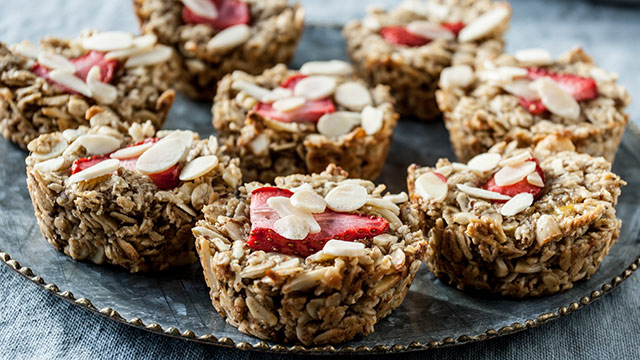Move
Modify Your Way to Results

And did you know? If you’re doing a class in the studio, you can ask your instructor any time for help when you modify. For online workouts, head to the community board and post your question—an instructor will get back to you with personal support.
POWER LEG. If you feel foot or ankle pain when you raise your heels high in this posture, modify by barely hovering your heels. You can also substitute Power Leg with a flat-footed posture like Incline Seated Chair or Reverse Seated Chair. If you feel lower-back or knee pain in this posture, work higher by not bending your knees as much, or substitute with a flat-footed posture.
SUMO. If you feel strain in your low-back or knees when you drop your seat, try walking your feet a little closer together and working higher, taking care to drop your ribs down. This will give you a deeper core connection, which will protect your back and knees.
CAROUSEL HORSE. If this posture strains your low back or causes pain in your back knee, perhaps your alignment is off and the correct muscles aren’t firing. Modify this posture by hinging forward. This will take the load off your back knee, which will help your glute muscles light up the way they should. If you hinge forward and still feel pain, consider working in parallel Incline Seated Chair instead. You’ll still get a deep muscle burn in your quads and glutes, but you won’t put any undue strain on your knees or back.
HORSE POSE. This posture depends largely on your bone structure and how prepped your body is. If your hips don’t allow you to work with your knees turned out so you can see your big toe, for example, or if your hamstrings are especially tight, you’ll want to work higher and walk your feet closer together. Keep in mind that the goal isn’t about how low you go in this posture. It’s about alignment and pushing deeper into the ground in order to fire your powerhouse muscles. Not sure what horse pose looks like? Click here for a nifty GIF.
BRIDGE LIFTS. This posture should engage your glutes, but if you feel it in your lower back, then your glutes aren’t working for you. Working smaller, more slowly, and/or adjusting your foot placement can help you find your sweet spot. Another great modification is to hold weights on your hip points. The extra weight will cause your glutes to fire, giving you the connection you’re looking for.


And did you know? If you’re doing a class in the studio, you can ask your instructor any time for help when you modify. For online workouts, head to the community board and post your question—an instructor will get back to you with personal support.
POWER LEG. If you feel foot or ankle pain when you raise your heels high in this posture, modify by barely hovering your heels. You can also substitute Power Leg with a flat-footed posture like Incline Seated Chair or Reverse Seated Chair. If you feel lower-back or knee pain in this posture, work higher by not bending your knees as much, or substitute with a flat-footed posture.
SUMO. If you feel strain in your low-back or knees when you drop your seat, try walking your feet a little closer together and working higher, taking care to drop your ribs down. This will give you a deeper core connection, which will protect your back and knees.
CAROUSEL HORSE. If this posture strains your low back or causes pain in your back knee, perhaps your alignment is off and the correct muscles aren’t firing. Modify this posture by hinging forward. This will take the load off your back knee, which will help your glute muscles light up the way they should. If you hinge forward and still feel pain, consider working in parallel Incline Seated Chair instead. You’ll still get a deep muscle burn in your quads and glutes, but you won’t put any undue strain on your knees or back.
HORSE POSE. This posture depends largely on your bone structure and how prepped your body is. If your hips don’t allow you to work with your knees turned out so you can see your big toe, for example, or if your hamstrings are especially tight, you’ll want to work higher and walk your feet closer together. Keep in mind that the goal isn’t about how low you go in this posture. It’s about alignment and pushing deeper into the ground in order to fire your powerhouse muscles. Not sure what horse pose looks like? Click here for a nifty GIF.
BRIDGE LIFTS. This posture should engage your glutes, but if you feel it in your lower back, then your glutes aren’t working for you. Working smaller, more slowly, and/or adjusting your foot placement can help you find your sweet spot. Another great modification is to hold weights on your hip points. The extra weight will cause your glutes to fire, giving you the connection you’re looking for.













9 people have left a comment. Join the conversation!
View Comments